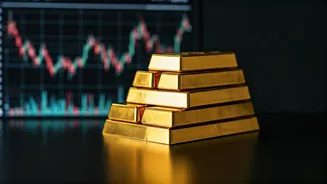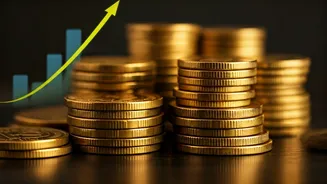The Golden Rush
Gold's enduring appeal in India stems from its status as a symbol of wealth, security, and a hedge against economic uncertainties. Historically, Indians
have favored gold for both investment and cultural purposes, making the nation one of the largest consumers of gold globally. The current rise in gold prices is primarily influenced by several key factors. One major driver is the global economic climate, with concerns about inflation, geopolitical tensions, and currency fluctuations. Investors often turn to gold as a safe-haven asset during uncertain times, which boosts demand and subsequently, prices. Another critical element is the strength of the dollar and other currencies. A weakening currency often makes gold, priced in dollars, more affordable for buyers using other currencies, thus increasing demand. Furthermore, supply chain disruptions, especially in the context of sourcing and refining gold, contribute to price increases. These issues also add pressure to the costs. Consequently, the combination of these factors creates a dynamic market where prices are subject to continuous adjustments, reflecting the interplay of supply, demand, and global economic forces, which ultimately impacts investment decisions and consumer behavior.
India's Gold Story
For Indian households, rising gold prices have a dual impact. On one hand, it increases the value of existing gold holdings, making them wealthier on paper. This can give a feeling of financial comfort. Many Indians own gold in the form of jewelry, coins, and bars. As prices go up, the market value of these possessions increases. However, the same rising prices make it more expensive to buy new gold. This can affect festive seasons, weddings, and other times when gold is traditionally purchased. High prices might also impact spending and investment habits, forcing consumers to think carefully about their financial decisions. However, gold’s role as an investment asset means that even with rising prices, gold can still be a good investment choice. Gold's ability to retain and grow its value over time makes it a popular option to preserve wealth. Various investment avenues such as gold ETFs, sovereign gold bonds, and gold mutual funds are available. These options provide a way for Indians to participate in the gold market without physically owning the metal, offering liquidity and flexibility to manage their investment portfolios. The Indian market's reaction to gold price fluctuations is a complex dance between cultural significance, economic indicators, and investment strategies.
Global Drivers
Several global trends significantly influence the rise in gold prices. Economic instability plays a large role. When the global economic outlook becomes uncertain, investors often consider gold as a safe investment. The metal's role as a haven is a powerful driver of demand, pushing prices upward when economic risks are high. Furthermore, fluctuations in currency values are essential. When major currencies like the US dollar weaken against other currencies, gold, which is priced in dollars, becomes cheaper for international buyers, raising the global demand. Interest rate policies from major central banks also affect gold prices. As interest rates rise, the appeal of gold may be suppressed as investors may prefer interest-bearing assets. However, if central banks adopt dovish policies, it can make gold more attractive. Geopolitical events also trigger changes. International conflicts and political unrest enhance gold's status as a safe investment, boosting prices. Supply chain issues and production costs also influence the prices. Disruptions in the supply chain and higher production costs can restrict the available supply of gold, leading to higher prices. The intricate interplay of these global factors underscores the complexity of the gold market. Investors, consumers, and policymakers must understand these trends to make informed decisions and navigate the impact of rising gold prices effectively.
Gold’s Future
Looking ahead, the future trajectory of gold prices will largely depend on how these global factors evolve. Economic forecasts, including inflation rates, interest rate policies, and economic growth projections, will continue to play a pivotal role. As economic risks intensify, demand for gold as a safe haven will likely persist, potentially leading to more price increases. However, if inflation decreases and economies stabilize, the appeal of gold could decline. The strength of major currencies will also be important. A weak US dollar and other major currencies will likely make gold attractive for international buyers, thus driving demand. Central bank policies, especially decisions related to interest rates, will have significant influence. A more aggressive monetary policy may put downward pressure on gold prices, while a more relaxed approach could make gold more attractive. Furthermore, any changes in geopolitical conditions, such as international conflicts and political crises, will likely boost gold prices as investors seek safer investment options. Supply-side factors, including production and refining capacity, will also be influential. Any disruptions or constraints in the supply chain could keep gold prices high. Overall, the gold market is dynamic, and understanding its complexities will be essential for making future decisions.












